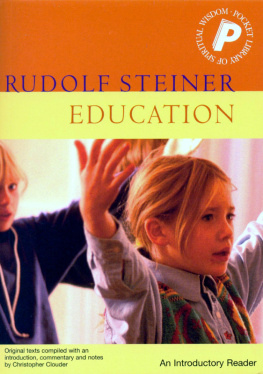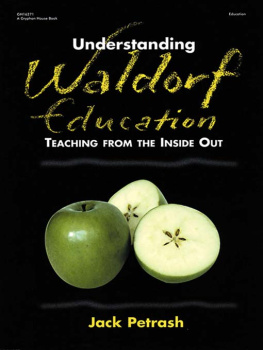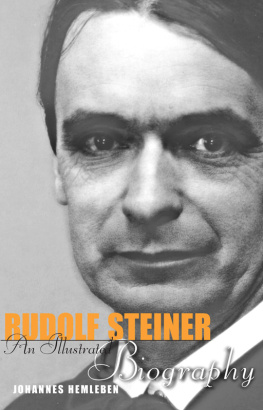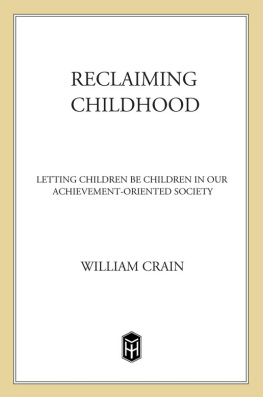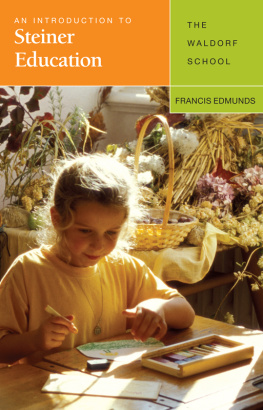THE
WAY OF A CHILD
A. C. Harwood
Sophia Books
Sophia Books
Rudolf Steiner Press
Hillside House, The Square
Forest Row, East Sussex
RH18 5ES
First edition 1940, Rudolf Steiner Press, London; reprinted 1940
Second edition 1942; reprinted 1945
Third edition 1952
Fourth edition 1967; reprinted 1974
Fifth edition 1979, Pharos Books (Rudolf Steiner Press), London
Sixth edition 1982, Pharos Books; reprinted 1988, Rudolf Steiner Press
This edition 1997
(Sophia Books is an imprint of Rudolf Steiner Press)
Rudolf Steiner Press 1997
The moral right of the author has been asserted under the Copyright, Designs and Patents Act, 1988
All rights reserved. No part of this publication may be reproduced, stored in a retrieval system, or transmitted, in any form or by any means, electronic, mechanical, photocopying, recording or otherwise, without the prior permission of the publishers
A catalogue record for this book is available from the British Library
ISBN 978 1 85584 352 3
Cover by Andrew Morgan
Typeset by DP Photosetting, Aylesbury, Bucks
CONTENTS
Chapter 1
The Physical Basis of Spiritual Life
Chapter 2
The Childs Relation to the Threefold Organism and the Threefold Powers of the Soul
Chapter 3
Conscious Powers and Organic Activity
Chapter 4
The Heart of Childhood
Chapter 5
Life Forces and Death Forces
Chapter 6
The Birth of the Ego
Chapter 7
Between the Individual and the GeneralThe Temperaments
Chapter 8
The Form of a School
Chapter 9
Education and Society
INTRODUCTION
Cecil Harwoods book on Steiner Waldorf education was first published 57 years ago. That it is now being reissued shows how it has withstood the test of time. The author was the first male Waldorf teacher in this country and was therefore intensely involved in the establishment of the education in its early years and intimately experienced the struggles and joys of his fellow pioneers. It is said that when Rudolf Steiner spoke to the four women who were inspired to begin such schools in the UK during the course of lectures he was giving in Ilkley, Yorkshire, in August 1923, he pointed out to them that they would also need a man to work with them. That it was Harwood who took up this challenge was due to the fact that while recuperating from an illness in Torquay during the following summer it was suggested that he might find some lectures being given by Steiner in the town at that time of interest. He went on to be one of the founding teachers of the first Waldorf school in the English-speaking world, now known as Michael Hall.
This book is redolent of the age in which Harwood lived and worked and much has changed in the intervening period that has had profound effects on the schools and the practice of Waldorf education. The present challenges facing the school communities were undreamed of in Harwoods time. Looking back it is as though in spite of lifes tribulations and the recent calamitous events in Europe there was a pervasive sense of inner security and outer certainty that we have now lost, and his book exudes this atmosphere. Yet the gentle humanity and assuredness are still relevant in that they can convey a composed approach in the midst of our much more driven and fragmented society. In our world of instant communications, where what is used for this purpose has become obsolescent before we have understood how to use it, where the environment becomes an issue of preoccupation and anxiety and even the sun has become the enemy of health, where vocational life has, in many instances, become a continuous pursuit to construct a creditable portfolio, it can be refreshing to hear the voice of mature thought and consideration.
There are qualities that have not been changed by these contemporary factors, and these are best described as the enduring aspects of the human spirit. It is these more timeless questions that are addressed here within a classical frame of mind that is able to put them into context of any passing cultural phenomenon. Children have developed and grown in much the same way in all epochs and all parts of the world, and in speaking to these aspects of the teaching and parenting task the risk of irrelevance to future generations is much reduced. Schools must be humane places where each individuals humanity is allowed to unfold. By working with the concepts and ideals of a less pressurized time, albeit irrevocably passed, we can find the inspiration to create the opportunity and space for this to happen and simultaneously to feel sure that they are not only appropriate but also vitally necessary for the health and confidence of the children in our care.
That which is now recognized as Steiner Waldorf education will be very different in the times to come, to the extent that it will be even further removed from some of the descriptive passages in this text. The number of schools has grown tenfold since it was written and Steiner Waldorf schools can now be found in more than 40 different countries. This development has deep implications for the curriculum in all of these schools. An active international consciousness will be needed to truly serve the needs of a future global citizenship. Teachers can no longer assume unquestioned professional authority and parents rightly expect to be able to be more involved in their childrens education and to take a larger role in the actual running of the school. New management structures are required which contain a greater degree of answerability, and teacher appraisal and mentoring is here to stay. Children too have changed and are deeply influenced by the general restlessness of society and less established interpersonal relationships. Schools are having to work more assiduously on the concepts of moral education and even take on the tasks previously exercised by parents or the extended family. However the inner approach and basic principles of Steiner Waldorf education will remain, and for this purpose this book has much to recommend it as a particularly English contribution to a continuously evolving form of worldwide education. Cecil Harwood was an erudite protagonist of a more sensitive awareness and respect for the innate wisdom of childhood, and his writings give us a sympathetic and loving picture of how this should be the basis of any worthwhile educational endeavour.
Christopher Clouder
Chairman, Steiner Waldorf Schools Fellowship
March, 1997
AUTHORS PREFACE
This little book is entirely based on the study of Rudolf Steiners books and lectures on childhood and education, and on many years experience as a teacher in a school founded to carry out his ideas. I have not endeavoured to distinguish between what is immediately contained in his own works and anything that my own thought and experience may have taught me, or that I may have added by way of illustration. Rather have I tried (as I think he would have wished) to present in my own way that limited part of his work which I feel I have best understood and made my own. A list of such of his own works on education as are translated into English will be found at the end of the book.
I found in writing that the subject matter did not allow that any one theme should be confined to a single chapter, but a theme which had been introduced in one chapter had often to be approached from new points of view in succeeding chapters. I hope that repetition of a theme will always be found to have carried the matter further.
A. C. H.
1. THE PHYSICAL BASIS OF SPIRITUAL LIFE
It is a right instinct among children to wish to be grown-up. Healthy children do not desire to stay with Peter Pan in the garden of childhood, but long for that freedom of their powers which they feel will come to them when they reach the distant and hardly conceivable land of adulthood. The instinct is a right one because childhood has only meaning or beauty in that it is a preparation for a different state. Its charm is that it stays only for a moment; its importance is that it will not return. It matters very much that children should be helped to win from childhood all the qualities that it has to give. But no one will be able to help them to do so who is uncertain of the goal towards which childhood is striving, because he has not formed a clear picture of the powers of the fully grown man.
Next page


